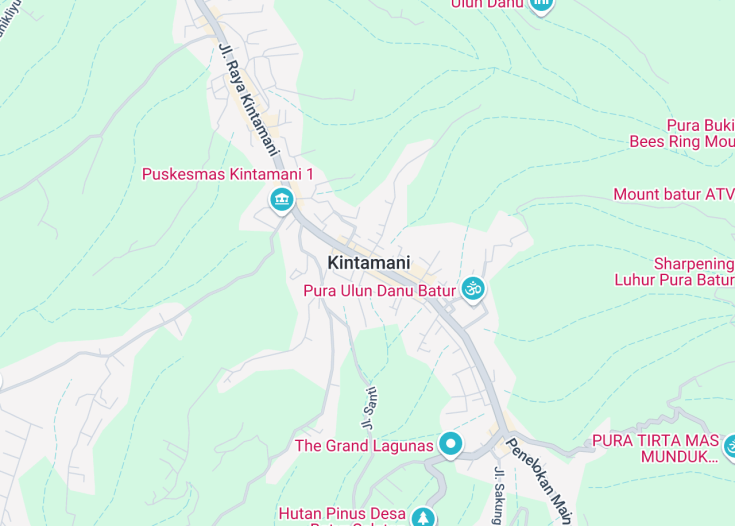Kintamani, nestled on the picturesque slopes of Mount Batur in Bali, Indonesia, offers a unique blend of breathtaking natural landscapes and vibrant cultural heritage. Renowned for its majestic panoramic views of Batur Lake and the active volcano, it provides a serene yet adventurous escape.
Visitors can indulge in extraordinary experiences such as sunrise trekking, relaxing in natural hot springs, and exploring age-old temples, all set against a backdrop of lush greenery and volcanic vistas ensuring a mesmerizing and enriching travel experience.
For an enhanced experience, visit Kintamani during the early morning to capture the stunning sunrise over Mount Batur, before the crowds arrive.
Consider planning your visit around local festivals to immerse yourself fully in the cultural fabric of Kintamani and to enjoy traditional Balinese festivities.
Top things to do & see in Kintamani
Select the following sights and activities to discover best tickets and tours available in Kintamani.
Kintamani: Indonesia’s Crater Paradise
| Country | Indonesia |
| Time in Kintamani | GMT+8 |
| Language spoken | Indonesian |
| Population | 91,000 (2023 est.) |
| Currency | Indonesian Rupiah (IDR ₪) |
| Airports |
|
Kintamani, nestled in the northeastern highlands of Bali, Indonesia, is famed for its breathtaking views of Mount Batur and its serene crater lake. Known as a haven for nature lovers and adventure seekers, this region boasts a rich blend of natural beauty and cultural heritage. Exploring Kintamani gives visitors a glimpse into the rural Balinese life that pulsates with the rhythms of nature and tradition.
The history of Kintamani is deeply intertwined with the volcanic activity of Mount Batur. The area has been shaped and reshaped by numerous eruptions, the most recent being in the 20th century. The fertile volcanic soil supports the cultivation of oranges and coffee, making agriculture an integral part of the local economy. Besides agriculture, tourism plays a significant role, drawing visitors to its hiking trails, hot springs, and panoramic views.
The area is not only geologically significant but also culturally rich. The local people follow a unique form of Hinduism, evident in their rituals, ceremonies, and the magnificent temples dotted across the landscape. The Pura Ulun Danu Batur is one of the nine key directional temples on the island and a pivotal site for pilgrimages.
A visit to Kintamani offers more than just scenic beauty. It provides an opportunity for cultural immersion, adventure tourism, and a chance to witness the harmonious balance between humanity and nature. Whether it’s a trek up Mount Batur to catch a sunrise or a leisurely exploration of rural villages, Kintamani encapsulates the essence of Bali’s enchanting allure.
Where is Kintamani?
Located in the district of Bangli in the northeastern part of Bali, Indonesia, Kintamani boasts a stunning, elevated landscape.
Distances:
| Route | Distance by car | Time by car |
|---|---|---|
| Denpasar to Kintamani | 55 miles (88 km) | 2 hours |
| Ubud to Kintamani | 25 miles (40 km) | 1 hour |
What is Kintamani famous for?
Kintamani is renowned for its dramatic landscape centered around the active Mount Batur and its crater lake. Its cultural heritage and natural hot springs also attract many visitors.
History
Prehistoric Era to 19th Century
Kintamani’s history is as rich and layered as the volcanic soil that blankets the region. Early human activity in the area is evidenced by archaeological finds dating back to the prehistoric period. These include farming tools and remnants of early settlements. The fertile land, coupled with the abundant natural resources, made Kintamani a desirable location for these early inhabitants.
20th Century Development
The 20th century marked a pivotal era for Kintamani, transitioning from a primarily agrarian society to one that embraced the burgeoning tourism industry. The discovery of the area’s stunning natural beauty, particularly the panoramic views of Mount Batur and the lake, transformed Kintamani into a must-visit destination. During this period, infrastructure improvements were made to better accommodate tourists, such as the construction of roads and visitor centers.
21st Century and Present Day
In recent decades, Kintamani has continued to develop, balancing modernity and cultural preservation. The area has seen significant advancements in sustainable tourism practices, aiming to protect and preserve its natural landscapes and cultural heritage. Today, Kintamani remains a cherished site, not only for the breathtaking vistas and natural wonders but also for its rich cultural offerings reflective of Balinese tradition.
Visit Kintamani
What to see and do in Kintamani, Indonesia
Visitors to Kintamani are treated to a landscape of stark contrasts and natural beauty. Highlights include:
- The majestic Mount Batur, a still-active volcano that offers trekking opportunities and unforgettable sunrise views.
- The serene Lake Batur, ideal for a relaxing boat ride or for simply enjoying the tranquility.
- Local hot springs where one can unwind and enjoy the therapeutic benefits.
- Traditional Balinese villages around the region, offering insights into the local culture and traditions.
Annual Festivals in Kintamani
Kintamani hosts a variety of cultural and natural festivals throughout the year, celebrating everything from the unique Balinese culture to the bountiful harvests of the region.
Notable events include the Kintamani Coffee Festival in mid-September and the Pesta Ulun Danu, a water festival held in March that venerates the lake and crater gods.
Best time to visit Kintamani
The best times to visit Kintamani are during the dry seasons, from April to October, when the weather is most comfortable for outdoor activities and the views are least obstructed by fog.
Is Kintamani worth visiting?
Kintamani is unequivocally worth visiting for anyone seeking a blend of adventure, natural beauty, and cultural enrichment. The area offers a unique glimpse into the Balinese way of life, set against the dramatic backdrop of an active volcano and a beautiful crater lake.
Whether you’re interested in hiking, experiencing local customs, or simply relaxing in natural hot springs, Kintamani provides a captivating and enriching experience.









